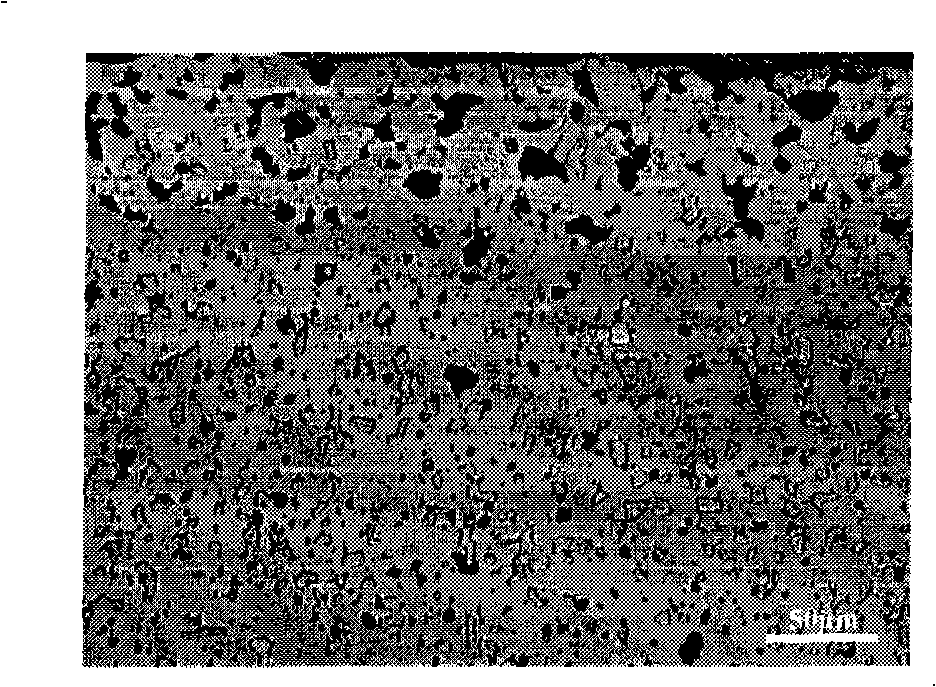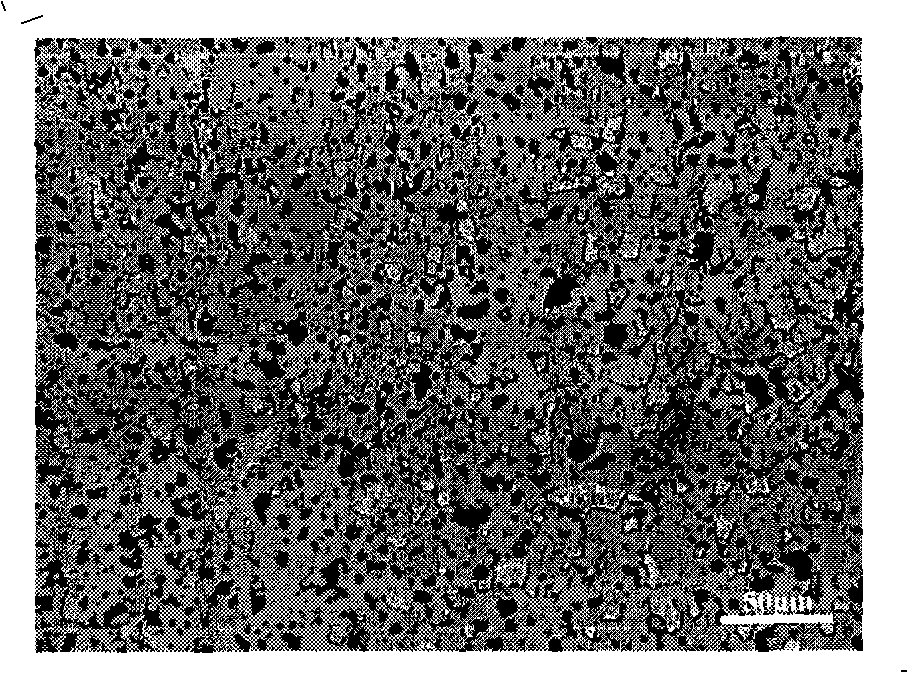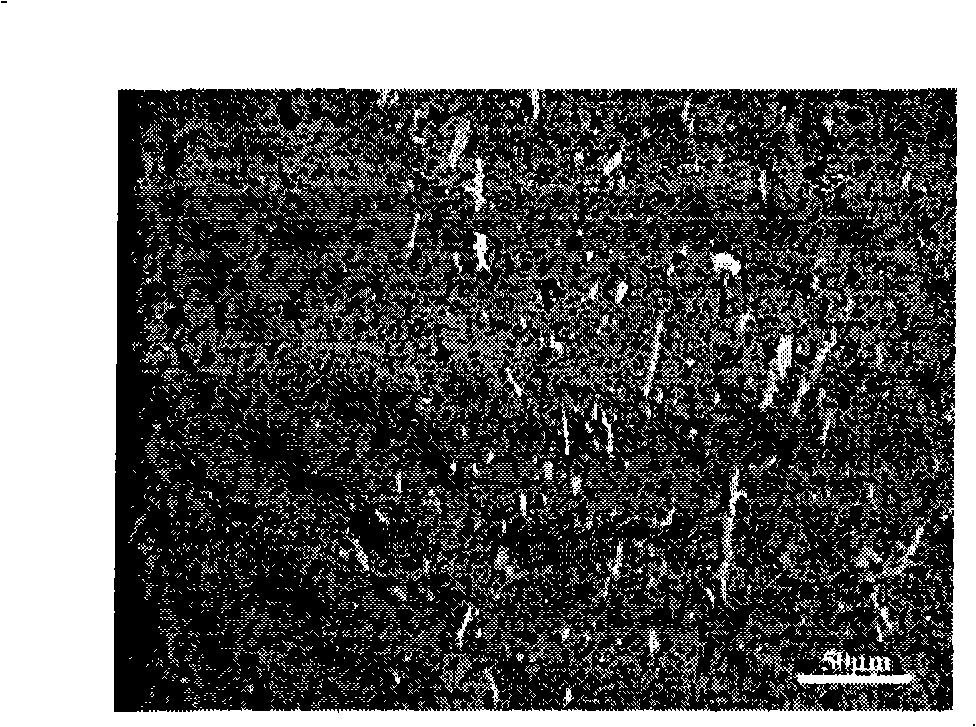Metal ceramic inert anode for molten salt electrolysis and preparation method thereof
A technology of cermet and molten salt electrolysis, which is applied in the direction of electrodes, electrolysis process, electrolysis components, etc., can solve the problems of poor conductivity, inert anode structure and performance decay, and difficult connection of metal guide rods, etc., to ease thermal expansion mismatch, Solve the effect of selective dissolution and benefit high temperature conductive connection
- Summary
- Abstract
- Description
- Claims
- Application Information
AI Technical Summary
Problems solved by technology
Method used
Image
Examples
Embodiment 1
[0045] Example 1: CaO-Cu-NiO-NiFe 2 O 4 Cermet inert anode
[0046] CaO-Cu-NiO-NiFe 2 O 4 The raw material formula of the cermet inert anode is shown in Table 1. First, weigh NiO and Fe respectively according to 1.35:1 (molar ratio) 2 O 3 Powder, where NiO powder has a particle size of 10μm, Fe 2 O 3 The particle size of the powder is 10μm, and it is dispersed with at least one of industrial alcohol or water, phthalic acid, oleic acid, ammonia salt solution, polyacrylamide solution, fish oil, butyl phthalate, polyacrylate, and polyacrylamide. It was treated by ball milling for 8 hours, dried at 80°C for 24 hours, and then put into a corundum crucible, placed in a resistance furnace in an air atmosphere, and calcined at 1200°C for 6 hours to obtain composite ceramic powder with an average particle size of about 10μm. X-ray diffraction phase analysis shows that the ceramic powder mainly contains NiO and NiFe 2 O 4 Two-phase. Then take the pre-prepared NiO-NiFe 2 O 4 The powder is a ...
Embodiment 2
[0049] Example 2: CaO-Ni-NiFe 2 O 4 Cermet inert anode
[0050] CaO-Ni-NiFe 2 O 4 The raw material formula of the cermet inert anode is shown in Table 2. First weigh NiO and Fe at 1:1 (molar ratio) 2 O 3 Powder, where NiO powder has a particle size of 20μm, Fe 2 O 3 The particle size of the powder is 20μm, and it is dispersed by at least one of water or industrial alcohol, phthalic acid, oleic acid, ammonia salt solution, polyacrylamide solution, fish oil, butyl phthalate, polyacrylate, and polyacrylamide It was treated by ball milling for 8 hours, dried at 80°C for 24 hours, then placed in a corundum crucible, placed in a resistance furnace in an air atmosphere, and calcined at 1200°C for 6 hours to obtain composite ceramic powder with an average particle size of about 18μm. X-ray diffraction phase analysis shows that the ceramic powder mainly contains NiFe 2 O 4 phase. Then take the pre-prepared NiFe 2 O 4 The powder is a ceramic phase base material, and 2% (mass percentage, the...
Embodiment 3
[0053] Example 3: CaO-BaO-Ni-NiO-NiFe 2 O 4 Cermet inert anode
[0054] CaO-BaO-Ni-NiO-NiFe 2 O 4 The raw material formula of the cermet inert anode is shown in Table 3. First, weigh NiO and Fe respectively according to 1.35:1 (molar ratio) 2 O 3 Powder, where NiO powder has a particle size of 50μm, Fe 2 O 3 The powder particle size is 50μm, and it is dispersed with at least one of phthalic acid or industrial alcohol, water, oleic acid, ammonia salt solution, polyacrylamide solution, fish oil, butyl phthalate, polyacrylate, and polyacrylamide It was treated by ball milling for 8 hours, dried at 80°C for 24 hours, and then placed in a corundum crucible, placed in a resistance furnace in an air atmosphere, and calcined at 1200°C for 6 hours to obtain composite ceramic powder with an average particle size of about 32μm. X-ray diffraction phase analysis shows that the ceramic powder mainly contains NiFe 2 O 4 phase. Then take the pre-prepared NiFe 2 O 4 The powder is a ceramic phase b...
PUM
| Property | Measurement | Unit |
|---|---|---|
| particle size | aaaaa | aaaaa |
| particle size | aaaaa | aaaaa |
| particle size | aaaaa | aaaaa |
Abstract
Description
Claims
Application Information
 Login to View More
Login to View More - R&D
- Intellectual Property
- Life Sciences
- Materials
- Tech Scout
- Unparalleled Data Quality
- Higher Quality Content
- 60% Fewer Hallucinations
Browse by: Latest US Patents, China's latest patents, Technical Efficacy Thesaurus, Application Domain, Technology Topic, Popular Technical Reports.
© 2025 PatSnap. All rights reserved.Legal|Privacy policy|Modern Slavery Act Transparency Statement|Sitemap|About US| Contact US: help@patsnap.com



